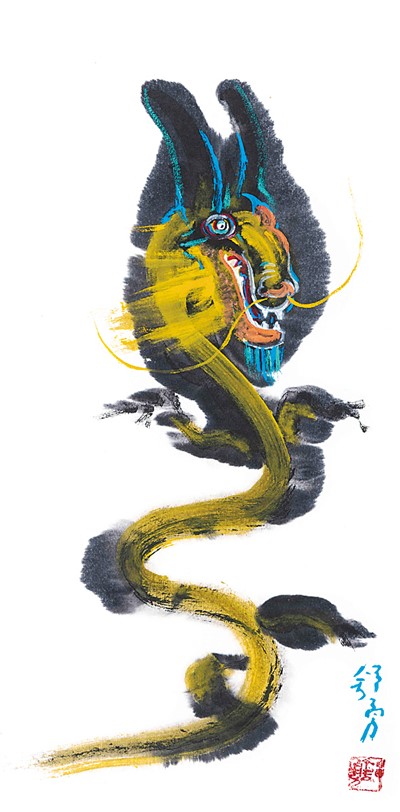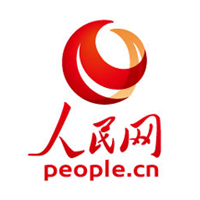 |
One of Shu Yong's ink dragon works |
In the history of Chinese art, there is a story of "finishing touch" that is widely known. It is said that Zhang Sengyao, the painter of the Liang Dynasty, painted two dragons on the middle wall of the temple. One dragon "broke the wall and flew" in the wind, rain and thunder after finishing its finishing touch, while the other dragon that had not finished its finishing touch remained on the wall. This idiom tells the modeling principle and spiritual essence of Chinese painting. At the arrival of the Year of Dragon, Shu Yong, member of the National Committee of the Chinese People's Political Consultative Conference, director of the Chinese Artists Association, and vice chairman of the Hunan Artists Association, created a series of leading ink paintings. These works are based on the current situation, continue the context, and are ingenious in content mining, modeling, image building, skill training, etc. They not only highlight the traditional Chinese aesthetic ideas, but also highlight the characteristics of the times and cultural spirit.
Focus on the spirit
Display of the spirit of the times
Dragon plays an important role in Chinese traditional culture. The dragon in Shu Yong's works does not stay in the "shape" presentation of the dragon itself, but guides the painting to the height of human spirit through the vivid description of the shape, which profoundly and implicitly shows the spiritual atmosphere of the new era.
Shu Yong condenses the cultural spirit of contemporary Chinese people in his pen and ink. The dragon in his painting focuses on the vivid expression of the spirit of the dragon, which is either passionate, intelligent, brave, or determined. It is a vivid portrayal of the spirit of the dragon and horse, and is the reflection of the cultural consciousness, self-confidence, and self-improvement of Chinese people in the new era.
"Eye" of point modeling
Close up
Different from other zodiac signs, the dragon does not exist in real life, which brings uncertainty to the painters' modeling, but also provides a broader space for imagination. Dong Yu of the Northern Song Dynasty in his Collection of Painted Dragons summed up painted dragons as "turning themselves in to the head, from the head to the belly, from the belly to the tail" and "head like cattle, mouth like donkeys, eyes like shrimp, horns like deer, ears like fish, scales like fish, whiskers like people, belly like snakes, claws like phoenix". These essentials of dragon painting become the rules and image annotations of dragon painting. Many of the dragon paintings are also closely related to clouds and water.
The difference between Shu Yong's drawing of dragons is that there is neither the "cloud dragon picture" of flying dragons in the sky nor the "rising dragon picture" of hidden dragons in the abyss, Focus on the dragon head as the performance object. If the past dragon paintings were more a panoramic view of the whole picture, Shu Yong's modeling was to focus on the local picture of the dragon head, giving a "close-up shot" of the magnified part. In the concrete presentation of the dragon head, he broke away from the constraints of the inherent images such as "ox head", "donkey mouth", "deer horn" and "shrimp eye", gave full play to his imagination, and created the image of cow instead of cow, donkey instead of donkey, deer instead of deer, shrimp instead of shrimp with freehand brushwork and exaggeration. As a kind of "image of human heart construction", this kind of modeling is marked with the unique mark of the artist and has produced a unique artistic effect.
"Eye" of Point Image
The performance of the unity of dragon and man
Chinese traditional culture highly values Tao following nature and the unity of heaven and man. Shu Yong attaches importance to the depiction of the face shape and expression of the dragon head, so that the dragon has the contour and characteristics of the face, like the incarnation of human beings, presenting the image that the dragon is the integration of human beings, that is, the dragon, and the integration of things and myself.
In the process of drawing a portrait of the dragon head, Shu Yong borrowed the Peking Opera facial makeup technique, one of the symbols of Chinese traditional culture, ingeniously. It is vaguely felt that the dragon seems to be wearing a certain type of Peking Opera facial mask, and the facial makeup of different dragon heads has their own strengths.
In order to inject vitality and spirituality into the fixed pattern of Peking Opera facial makeup, he gave full play to the characteristics of ink rendering, created a fresh and graffiti sense of the picture through the natural integration of water, ink color and lines, and presented a hazy and perceptible, sometimes like flowers blooming facial makeup image. With the symphony of color, ink and line, he formed a unique concept and mode of dragon painting, which integrates dragon, human and flower, and created an image of seeing dragon, human and flower in fog. The "meaning outside the image" of the dragon here has become a symbol of realizing freedom and purifying the soul in the forgetfulness of things and myself, which shows the ideological realm of Chinese painting's pursuit of "interaction between the spirit of the world and the independent".
"Eyes" of Point Technique
Innovation in the age of intelligence
While painting dragons with ink and wash, Shu Yong also tried to create with artificial intelligence. He first expressed his perception of the dragon through text description, and then directly translated the dragon he understood into images through artificial intelligence. He believes that AI can really, stereoscopically and richly restore or dissimilate the expression object, but there is no trace of brush, no vivid on paper. It can achieve high intelligence, high technology and high standards, but it can not present the instinct and nature of rough, graffiti and unskillful that accompanied the birth of human beings.
"Emotion" is the blind spot of AI creation. As a result, Shu Yong returned to the traditional techniques of ink painting and tried to find the comparative advantage of creativity through the comparison between ink painting and AI painting. On the one hand, he grasped the artificial intelligence technology, and integrated the freshness and sense of achievement that AI painting brought to artistic creation into ink painting, making the dragon painting more realistic, three-dimensional, and sounder; On the other hand, he carries forward the tradition of ink and wash painting, regards brushwork and brushwork as the soul and essence of Chinese painting, and explores the path of dragon painting of instinct and nature. Therefore, to some extent, these ink paintings are cultural experiments of confrontation and cooperation between human beings and artificial intelligence, and the crystallization of complementation and integration of ink painting and artificial intelligence. Through artistic practice, painters ponder how we can promote cultural integrity and innovation with an open and inclusive attitude when the era of artificial intelligence is coming.
The above four aspects, both inheritance and creation, are "Tao" and "art". In fact, everyone is a painter of life in this new era when everything is new. As long as we are brave and good at being the "anchor" of life, we will be able to draw a picture of life that breaks the wall and soars to the sky. This is also a greater enlightenment from Shu Yong's drawing of dragons.
(The author is the vice chairman of Hunan Literature and Art Critics Association)
(Editor in charge: Wang Lianxiang, Li Nanhua)
Share to let more people see





































